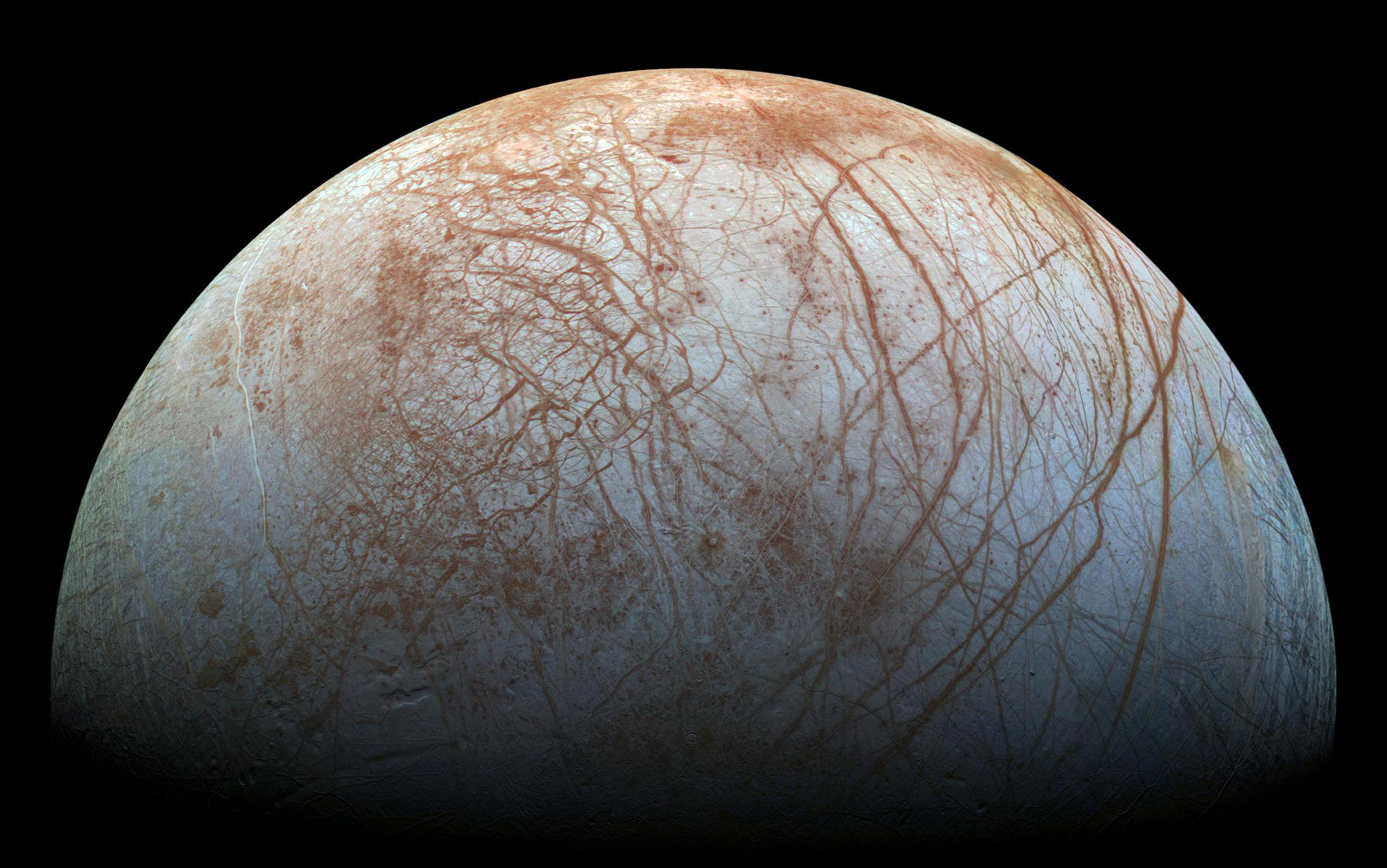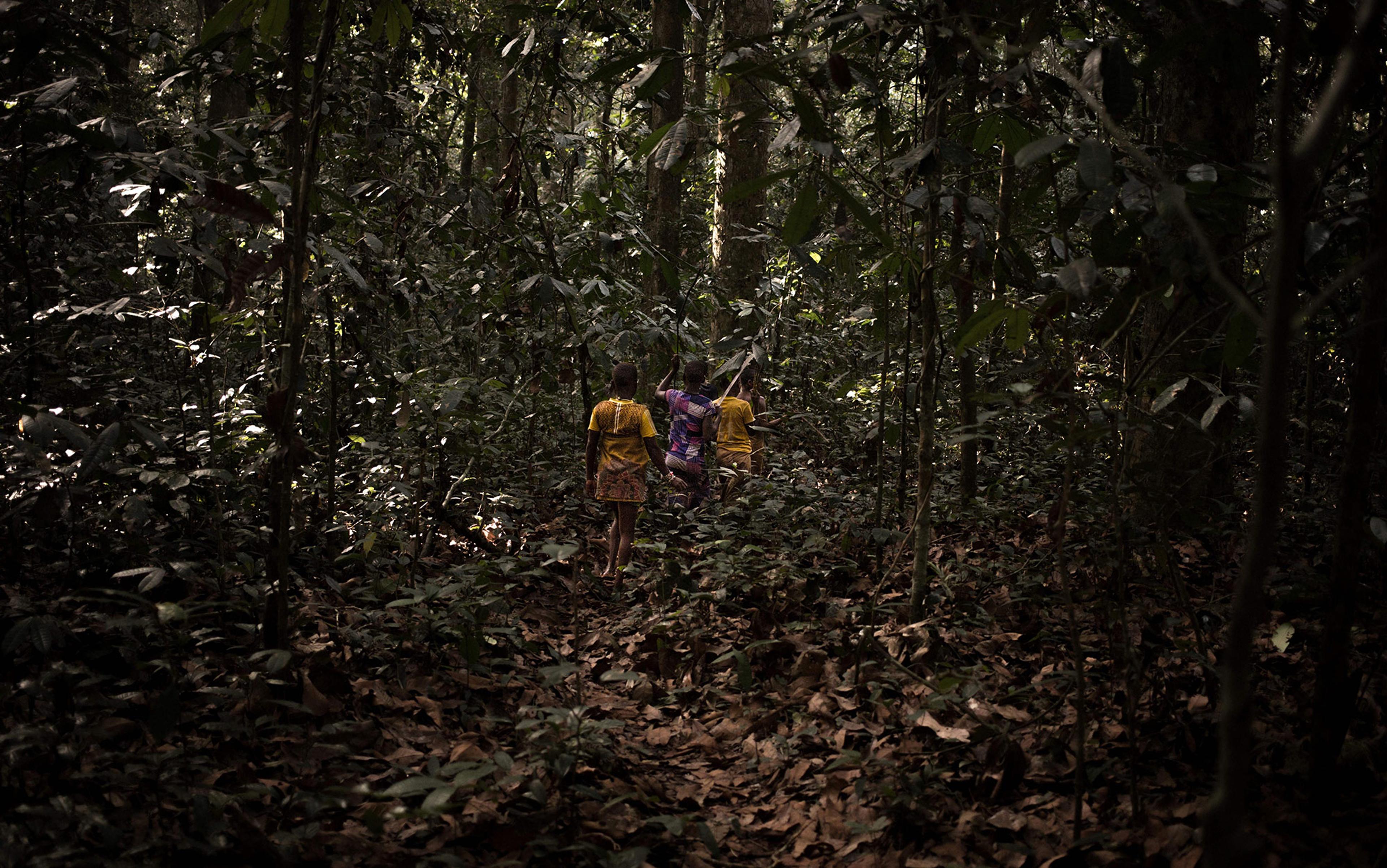The largest and deepest body of water known to us has never been sailed upon; it has no islands or shores, no wind-churned waves, no sunlight-silvered surface. This dark ocean can’t be found on any map of Earth – it’s more than 300 million miles away, on Europa, one of at least 69 moons that orbit Jupiter. Data from the Galileo spacecraft, which flew past Europa 11 times between 1995 and 2003, revealed that an immense salty sea lies beneath this moon’s smooth icy surface. Estimated to be 60 miles deep – about eight times the maximum depth of the Pacific – it has two to three times as much water as all of Earth’s oceans combined.
And Europa isn’t some singularly soggy outlier. At least two additional Jovian moons – Ganymede and Callisto – have subsurface oceans. Titan and Mimas, which orbit Saturn, probably do, too. And there’s no doubt that another Saturnian moon, Enceladus, harbours water beneath its frozen crust, probably a volume comparable to the Great Lakes. Astonishing and irrefutable evidence for Enceladus’s briny deep came in 2005 when the Cassini space probe captured images of geysers spouting ice and water vapour hundreds of miles into space. Cassini even flew right through the geysers in October 2015, skimming within 30 miles of the moon’s surface to sample their contents.
To say that the abundance and ubiquity of liquid water in the outer solar system completely upended scientists’ expectations doesn’t do justice to the discoveries. Before the revelations provided by Cassini, Galileo and other probes, the consensus was stark: the moons around Jupiter and Saturn would look much like our own or those of Mars – rocky, crater-pocked wastelands utterly hostile to life. ‘Nobody expected that there were subsurface oceans,’ says Seth Shostak, an astronomer with the SETI Institute in Mountain View, California. ‘It extends our concept of habitability and where you might find life to worlds that we hadn’t considered before. We always assumed that it had to be on a planet. I reckon there are seven other places in our solar system where we have reason to think there might be life – at least the conditions for life. Seven! And most of them are moons!’
With so much water in our own neck of the cosmos, it’s almost certain that countless planets around other stars must have oceans too, not to mention retinues of wet moons. Astronomers have already tentatively identified a few ‘water worlds’ beyond our solar system – planets with no dry land at all. ‘It’s mind-boggling,’ says Christopher Glein, a Cassini mission scientist at the Southwest Research Institute in San Antonio, Texas. ‘It’s like inventing a new field of oceanography.’
In hindsight, maybe the presence of extraterrestrial oceans shouldn’t have been such a surprise. Hydrogen makes up 74 per cent of the ordinary matter in the Universe; oxygen is the third most-common element in existence. Combine the two, and you get… H2O. Astronomers have observed traces of water ice in craters on the Moon and even on Mercury – the planet closest to the Sun. It’s common in interstellar clouds and in the dusty disks of nascent planetary systems; it has already been detected in the atmospheres of some giant exoplanets.
‘The study of exoplanets has been so explosive,’ says Bonnie Meinke, deputy project scientist for NASA’s James Webb Space Telescope, an exoplanet-spotting instrument scheduled for launch next year. ‘In the last 20 years, we’ve gone from knowing a handful of exoplanets to knowing thousands. And we now know that, for every star you see in the night sky, there’s probably a planet up there with that star. I think that we can expect that most of those little planets around those stars have some kind of water on them.’
And where there’s water there might be life – ‘follow the water’ has long been an axiom among astrobiologists. What makes water so essential? The chemical reactions that fuel the engines of life require a liquid to dissolve and transport molecules throughout a cell. Water is one of the best solvents known; it remains liquid over a wider range of temperatures than almost any other substance. It’s possible that other liquids might fulfil water’s role in some truly alien biochemistries – lakes of liquid methane, for example, have been found on Titan. But so far there are no known exceptions to the life-needs-water rule.
So wouldn’t planets completely covered in that essential substance make ideal havens for life? Some recent research throws a giant wet blanket on such expectations: many worlds might actually have too much water for life to arise – or to thrive if it did get started. ‘More is not necessarily better,’ says Steven Desch, an astrophysicist at Arizona State University. Desch and his colleagues have been running computer simulations of the exotic geophysical and atmospheric environments that might be found on alien worlds. Their goal is to provide a sort of planetary field-guide for future generations of exoplanet hunters – Desch calls it a Periodic Table of Planets. It would rank the types of worlds most likely to contain evidence of life’s byproducts in their atmospheres – gases such as oxygen or methane, for example. Most importantly, those gases would have to be present in quantities large enough to be detectable by telescopes in the decades ahead. Says Desch: ‘We need to prioritise observations for those planets where we might get the best indicators of life.’
Water worlds, it turns out, might be one of the worst places to look. Desch’s team created a computer model of a planet resembling Earth in nearly every respect: its size and its cosy not-too-cold, not-too-warm Goldilocks distance from a stable, Sun-like star. Then they drowned that world with about five to seven times as much water as Earth has, enough to submerge all its continents. (‘If you put six oceans on Earth, that would cover Everest,’ says Desch.) By drenching their virtual world, they eliminated a crucial life-sustaining process that we Earthlings take for granted: the weathering of exposed rock.
Without rain or running water to erode rock, the seas on the world created by Desch’s team contained very little phosphorus, an indispensable element for all life. Seawater itself is simply not acidic enough to dissolve phosphorus as efficiently as freshwater can. ‘Phosphorus is super critical,’ says Tessa Fisher, a microbial ecologist at Arizona State University who worked with Desch. ‘In addition to RNA and DNA, it also makes up ATP, which is the energy-carrying molecule for pretty much all biochemistry as we know it. Terrestrial biochemistry as we understand it will not function in the absence of phosphorus.’
Desch and Fisher emphasise that their model doesn’t rule out the possibility of life on water worlds. The seas on such planets would probably contain some phosphorus, but not enough to support life on a scale that would leave a noticeable imprint on the atmosphere. ‘It would not have the 30 per cent oxygen atmosphere that you see on Earth,’ says Fisher. ‘It’s quite possible that a planet entirely covered by oceans could be inhabited. It’s just that the life there would be so marginal it’s extremely unlikely we would be able to detect it from Earth with near-term technology.’
The most Earth-like worlds detected might all be too wet or weighed down with ice for life
There probably are some worlds, though, with so much water that life would be impossible. Desch’s team estimated that an Earth-size planet with 10 per cent of its mass in the form of water would be completely lifeless. Such a planet would have the equivalent of 400 of Earth’s oceans; the immense pressures at the bottom of its sea would create exotic dense forms of ice known as ice-six or ice-seven. ‘That would really screw things up because you would have no water-rock interactions,’ says Desch.
As outlandish as those conditions seem, these worlds might be more common than rocky bodies such as Earth. Water and rock are probably equally abundant in planetary systems throughout the cosmos. In our own solar system, comets, some moons and the frozen denizens of the Kuiper Belt out beyond Pluto are thought to consist of equal amounts of ice and rock. ‘The outer planets are about 50 per cent ice,’ says Desch. ‘That’s normal. What’s not normal is how dry Earth is.’
From our parochial perspective, Earth seems to be the quintessential ocean planet – the Pale Blue Dot – dominated by its seas. But all those oceans amount to the thinnest of films on the planet’s surface. By mass, Earth is only .025 per cent water. With current technology, astronomers would be unable to tell if an exoplanet such as Earth had any water at all. Astronomers use two basic techniques to determine the compositions of exoplanets. First, they estimate a planet’s size by observing how much light it blocks as it passes in front of its star. Then they measure the ever-so-slight wobble imparted to the star by the orbiting planet, which yields the planet’s mass. Dividing the planet’s mass by its volume gets the density, which in turn gives astronomers a rough idea of the percentages of gas, rocky matter and water in the planet.
‘Think about how thin our ocean is,’ says Desch. ‘It doesn’t change Earth’s radius in any way.’ For now, he says, astronomers can tell if an exoplanet has oceans only if water accounts for about 10 per cent of its mass. And that, as mentioned above, would equal 400 Earth oceans, a life-crushing amount of water. So the only water worlds we can detect with existing technology would be unlikely to host any life. ‘That’s state of the art right now,’ says Desch. ‘We have the ability to look for water and we can see it when there is 10 per cent water, but that is way too much water.’
Seven such worlds orbit Trappist-1, a star 49 light-years away named by its Belgian discoverers for their favourite brand of beer. All of them are about Earth’s size, and three of them lie within their star’s habitable zone, orbiting at distances that allow for the existence of liquid water. They’re among the most tantalisingly Earth-like worlds detected so far, but they might all be too wet or weighed down with ice for life.
Gauging the compositions of remote planets from a few pixels-worth of light snagged by a telescope is an inexact science at best. Given those constraints, Desch and his colleagues estimate that the outermost planets of Trappist-1 consist of 50 per cent ice; the innermost planets seem to be at least 10 per cent liquid water and ice. ‘This is well beyond the extreme where you would cover continents,’ says Desch. ‘You would have hundreds, or even 1,000 kilometres of high-pressure ice at the bottoms of oceans. That’s a dead planet.’
So what will it take to identify a ‘live’ planet, one with an Earth-like mix of continents and seas, not too wet, not too dry? Given the range of possible worlds out there, there must be many like ours – but how will we find them? The James Webb Space Telescope (JWST) will dominate astronomy once it starts its five-to-10-year mission in 2020; it will be able to analyse the atmospheres of giant, Neptune-size exoplanets, and might even spot some ‘Super Earths’ – planets with masses two to 10 times that of Earth’s. But it will be too nearsighted to make out the atmospheres, let alone oceans, of such worlds.
‘It’s very difficult to look at something so small – the size of Earth passing in front of its star – and see that little sliver of atmosphere,’ says Meinke, the JWST deputy project scientist. ‘There are plans for future telescopes that should be able to do that, and I will make this prediction: I think we’ll be able to do that within my professional career. But Webb won’t be able to confirm water on a terrestrial-type planet.’
Telescopes capable of directly imaging the oceans and land masses of another world are probably at least a couple of decades away. And even then the resolution will likely be limited to a pixel or two for the entire planet. So here’s how one of the most portentous discoveries in the history of science – our first direct look at a world such as our own – might unfold: the colour of a single pixel will cyclically shift from blue to brown as a faraway planet pirouettes, alternately exposing its lands and seas to our eyes.
Before that day arrives, we might well find evidence of life in some of the exo-oceans much closer to home. And the most accessible such ocean is on Enceladus, which seems to have all the conditions needed for life. When the Cassini probe, racing along at almost 16,000 miles per hour, dived through Enceladus’s plumes of ice water in October 2015, its instruments detected hydrogen, carbon dioxide and methane, evidence that this moon probably has deep-sea hydrothermal vents much like Earth’s. ‘We literally tasted Enceladus’s ocean when we flew through the plume!’ says Glein, one of Cassini’s mission scientists.
The presence of hydrogen in particular was a sign that chemical reactions between hot rocks and saltwater at the bottom of Enceladus’s sea were breaking water apart into hydrogen and oxygen. A body as small as Enceladus normally wouldn’t be expected to have any measurable amounts of hydrogen at all – the element is so light, it should have escaped into space long ago. So Enceladus’s hydrogen must be continuously replenished somehow, and the most likely source is chemical reactions between hot rocks and water. Says Glein: ‘Once we found the hydrogen, we could conclude that there is definitely a lot of chemical energy – the exact type of energy that organisms in the deep Earth or in hydrothermal vents use to power themselves.’
‘Maybe there are some multicellular things but I doubt you have things like tuna!’
Methanogens – an ancient type of bacteria found around hydrothermal vents on Earth – combine hydrogen with carbon dioxide, a reaction that releases energy for their metabolism and methane as a waste product. Simple organisms much like these are thought to have populated Earth’s early oceans. Even now, billions of years after they first appeared, methanogens live independently of sunlight, forming the base of a weird food chain that supports ecosystems of tubeworms and giant clams.
Could some form of life more complex than bacteria have arisen on Enceladus, Europa or in the lightless depths of some other moon’s sea? ‘You might have bacterial life in these subsurface oceans but the energy sources to support much more complex organisms that require more food might be a stretch,’ says Shostak, the SETI astronomer. ‘It’s not to say it couldn’t happen – they’ve [the moons] been there for 4.5 billion years, so maybe there are some multicellular things but I doubt you have things like tuna!’
The only way we’ll answer such questions is to visit some of these worlds. NASA has already approved the Europa Clipper mission, which might launch as soon as 2024, and reach Jupiter by 2030. Plans call for the spacecraft to make 45 passes over Europa, coming within 16 miles of its ice-covered surface. Future missions that actually land on Europa, Enceladus or Titan will look for complex amino acids and other biomolecules uniquely produced by living things.
With only one example to go by – our own world – it’s impossible to say whether life is utterly ordinary or an improbable cosmic accident. ‘It’s commonly assumed that because the fossil or chemical evidence of life extends so far back into the past, that we think life started fairly quickly,’ says Glein. ‘And people have interpreted that as meaning that the origin of life is easy.’
Easy, hard or somewhere in between, we now know one thing for sure: if life needs water to get started, there’s no shortage of the stuff. ‘If we’re thinking about the requirements for life, the water part of that equation has been pretty much filled in for our solar system,’ says Glein, ‘and presumably across the Universe.’






